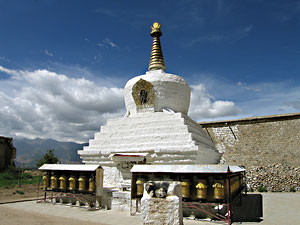|
Sera
Monastery
'Sera literally means 'Enclosure of Roses', is one of
the 'great three' Gelukpa university monasteries of
Tibet. The other two are Ganden Monastery and Drepung
Monastery. The monastery is about 5 km north of the
Jokang in Lhasa. It was founded in 1419, by Jamchen
Chojey (Sakya Yeshe), a disciple of Tsong Khapa. Like
the Drepung and Ganden monasteries, it had three
colleges, namely Sera Mey Dratsang, Sera Jey Dratsang,
and Ngagpa Dratsang. Sera Mey Dratsang was built in 1419
and used to give basic instruction to the monks, the
largest college, Sera Jey Dratsang was constructed
|
 |
|
|
in 1435, and
was reserved for wandering monks, especially Mongol monks.
Ngagpa Dratsang, built in 1559, was a school for the teaching
of the Gelukpa tantras. In 1959, Sera housed more than 5,000
monks. Although badly damaged, it is still standing and has
been largely refurbished. It now houses a few hundred Buddhist
monks. The Sera’s library houses some of the valuable prayer
books. Prayers books in Sera's library Graduates of Sera Jey
College who are known in the west include, Lama Thubten Yeshe,
Geshe Kelsang Gyatso, Lama Thubten Zopa Rinpoche. Graduates of
Sera Mey college who are known in the west include, Pabongka
Rinpoche—Author of Liberation in the Palm of Your Hands,
Kyabje Trijang Rinpoche—one of the current Dalai Lama's
teachers, Sermey Khensur Rinpoche Geshe Lobsang Tharchin—former
abbot of Sera Mey university in Bylakuppe.
Drepung Monastery
Literally means the 'Rice Heap' monastery', Drepang is also
one of the "great three" Gelukpa university monasteries of
Tibet. Drepung is the largest of all Tibetan monasteries, and
indeed at its peak was the largest monastery of any religion
in the world. Jamyang Chojey, who was a direct disciple of Je
Tsongkhapa, the founder of the Gelukpa school, founded it in
1416. It is located on the Gambo Utse mountain, 5 kms from the
western suburb of Lhasa. Before the Chinese invasion of Tibet
in 1959, the monastery housed fifteen thousand monks and was
known for the high standards of its academic study. Young
monks of Drepung are divided into what are known as the seven
great colleges - Gomang, Loseling, Deyang, Shagkor, Gyelwa or
Tosamling, Dulwa, and Ngagpa. Routines in Drepung monastery
are comprised of four parts: education, religious rites,
administration and sundry affairs. It can be a somewhat useful
analogy to think of Drepung as a university along the lines of
Oxford or the Sorbonne in the middle ages, the various
colleges having different emphases, teaching lineages, or
traditional geographical affiliations. Today the population at
the monastery is much smaller with merely a few hundred monks,
due to population capping enforced by the Chinese government.
Sakya Monastery
Sakya Monastery is the most treasured part of Tibetan soil.
The monastery was built in 1073 and has more than 900 years of
history. It is considered as the 'Second Danhuang'. The
monastery houses around 3000 pieces of sutras and precious
work of art that are over thousand years old. The main
attraction of the monastery is the Lakhang Chenmo hall that
covers more than 5500 square meters and has 40 huge pillars.
Even the big Chanting Sutra Hall is going to leave you
spellbound by its sheer size. The monastery is specially going
to be a wonderful treat for all antique and artifact lovers.
|